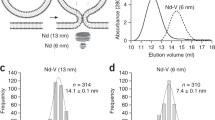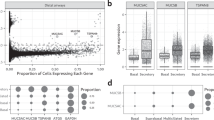Summary
The presence of excess membrane has been observed in the secretory granules of mast cells activated via the physiological mechanism of IgE receptor-mediated exocytosis. This excess membrane is the result of ade novo assembly from phospholipid, cholesterol, and other membrane components stored in the quiescent granule. Following receptor stimulation, membrane bilayer structures of varying size and shape can be seen in the subperigranular membrane space where the perigranular membrane has lifted away from the granule matrix. Vesicles as small as 25 nm in outer diameter are frequently found beneath the perigranular membrane at the site of granule fusion. Membrane in the form of elongated vesicles, tubes, or sheets has also been observed. The wide variation in size and shape of the newly assembled membrane may reflect the spontaneity of the entropy-driven membrane generation process and the fluid characteristic of the biological membrane in general. Fusion of the newly assembled membrane with the perigranular membrane enables the activated granule to enlarge. This rapid expansion process of the perigranular membrane may be the principal mechanism by which an activated granule can achieve contact with the plasma membrane in order to generate pore formation. The fact that new membrane assembly also occurs in the IgE receptor-mediated granule exocytosis, supports our observation thatde novo membrane generation is an inherent step in the mechanism of mast cell granule exocytosis. Whether new membrane assembly is a common step in the mechanism of secretory granule exocytosis in general, must await careful reinvestigation of other secretory systems.
Similar content being viewed by others
References
Albers, R. W., Chock, E. S., Donlon, M. A., &Chock, S. P. (1985) Localization of calmodulin in the mast cell granules.Fed. Proc. 44, 984 (abstr. 3353).
Alberts, B., Bray, D., Lewis, J., Raff, M., Roberts, K. &Watson, J. D. (1983)Molecular biology of the cell. p. 350. New York and London: Garland Publishing Inc.
Andreoli, T. E. (1974) Planar lipid bilayer membranes. InMethods in Enzymology (edited byFleischer, S. &Packer A.) Vol. 32, pp. 513–7. New York: Academic Press.
Blaschko, H., Firemark, H., Smith, A. D. &Winkler, H. (1967) Lipids of the adrenal medulla. Lysolecithin, a characteristic constituent of chromaffin granules.Biochem. J. 104, 545–9.
Broom, G. D. &Haegermark, O. (1965) A study on morphological changes and histamine release induced by compound 48/80 in rat peritoneal mast cells.Exptl. Cell Res. 40, 637–54.
Bloom, G. D. &Chakravarty, N. (1970) Time course of anaphylactic histamine release and morphological changes in rat peritoneal mast cells.Acta Physiol. Scand. 78, 410–9.
Bloom, G. D., Fredholm, B. &Haegermark, O. (1967) Studies on the time course of histamine release and morphological changes induced by histamine liberators in rat peritoneal mast cells.Acta. Physiol, Scand. 71, 270–82.
Chandler, D. E. &Heuser, J. E. (1980) Arrest of membrane fusion events in mast cells by quick-freezing.J. Cell Biol. 86, 666–74.
Chock, E. S., Donlon, M. A., Fiori, C. E. &Catravas, G. N. (1982) Elemental analysis for calcium in rat peritoneal mast cell granules.J. Cell Biol. 95, 409a.
Chock, S. P., Donlon, M. A. &Chock, E. S. (1984) Localization of calmodulin in the mast cell granules.Fed. Proc. 43, 1934 (abstr. 3026).
Chock, S. P. &Chock, E. S. (1985) A two-stage fusion model for secretion.Fed. Proc. 44, 1324 (abstr. 5341).
Chock, S. P. &Schmauder-Chock, E. A. (1985) Evidence ofde novo membrane generation in the mechanism of mast cell secretory granule activation.Biochem. Biophys. Res. Commun. 132, 134–9.
Chock, S. P. &Schmauder-Chock, E. (1987) The mast cell granules: A phospholipid source for prostaglandins synthesis. InProstaglandins and Lipid Metabolism in Radiation Injury (edited byWalden, T. L. &Hughes H. N.), pp. 127–32. New York: Plenum Press.
Chock, S. P. &Schmauder-Chock, E. A. (1988) Synthesis of prostaglandins and eicosanoids by the mast cell secretory granule.Biochem. Biophys. Res. Commun. 156, 1308–15.
Chock, S. P. &Schmauder-Chock, E. A. (1989) Phospholipid storage in the secretory granule of the mast cell.J. Biol. Chem. 264, 2862–8.
Chock, S. P. & Schmauder-Chock, E. A. (1990) Minireview. A new model for the mechanism of stimulus-secretion coupling.Biofactors (in press).
Curtis, S. K., Cowden, R. R. &Nagel, J. W. (1979) Ultrastructural and histochemical features of the thymus glands of the adult lungless salamander,Plethodon glutinosus (Caudata: Plethodontidae).J. Morphol. 160, 241–74.
Danielli, J. F. &Davson, H. (1935) A contribution to the theory of permeability of thin films.J. Cell. Comp. Physiol. 5, 495–508.
Douglas, W. W. (1974) Involvement of calcium in exocytosis and exocytosis-vesiculation sequence.Biochem. Soc. Symp. 39, 1–28.
Fonio, A. (1951) Uber das funktionelle verhalten der isolierten Strukturelements der Thrombocyten, des Hyalomers und des Granulomers.Acta Haemat. 6, 207–12.
Frank, H. S. &Evans, M. W. (1945) Free volume and entropy in condensed systems. III. Entropy in binary liquid mixtures; partial molal entropy in dilute solutions; structure and thermodynamics in aqueous electrolytes.J. Chem. Phys. 13, 507–32.
Helle, K. B. (1973) Biochemical studies of the chromaffin granule. III. Redistribution of lipid phosphate, dopamine-beta-hydroxylase and chromogranin A after freezing and thawing of the isolated granule membranes.Biochim. Biophys. Acta 318, 167–80.
Henderson, W. R. &Chi, E. Y. (1985) Ultrastructural characterization and morphometric analysis of human eosinophil degranulation.J. Cell Sci. 73, 33–48.
Huang, C. (1969) Studies on phosphatidylcholine vesicles. Formation and physical characteristics.Biochemistry 8, 344–52.
Huang, C. &Mason, J. T. (1978) Geometric packing constraints in egg phosphatidylcholine vesicles.Proc. Natl. Acad. Sci. USA 75, 308–10.
Ishizaka, K. (1985) Twenty years with IgE: From the identification of IgE to regulatory factors for the IgE response.J. Immunol. 135(1), i-x.
Ishizaka, K., Tomioka, H. &Ishizaka, T. (1970) Mechanism of passive sensitization. I. Presense of IgE and IgG molecules on human leukocytes.J. Immunol. 105, 1459–67.
Ishizaka, K. (1982) Biochemical analysis of triggering signals induced by bridging of IgE receptors.Fed. Proc. 41, 17–21.
Ishizaka, T., Sterk, A. R., Daeron, M., Becker, E. L. &Ishizaka, K. (1985) Biochemical analysis of desensitization of mouse mast cells.J. Immunol. 135, 492–501.
Kagey-sobotka, A., Macglashen, D. W. &Lichtenstein, L. M. (1982) Role of receptor aggregation in triggering IgE-mediated reactions.Fed. Proc. 41, 12–7.
Kanwar, U. &Kansal, M. (1980) Cytochemical studies on the prostate glands of the trematodes,Paramphistomum epiclitum andParadistomoides orientalis.J. Helminthol. 54, 263–6.
Kruger, P. G., Lagunoff, D. &Wan, H. (1980) Isolation of rat mast cell granules with intact membranes.Exp. Cell. Res. 129, 83–93.
Kowk, R. &Evans, E. (1981) Thermoelasticity of large lecithin bilayer membrane vesicles.Biophys. J. 35, 637–52.
Lagunoff, D. (1973) Membrane fusion during mast cell secretion.J. Cell Biol. 57, 252–9.
Langmuir, I. &Waugh, E. F. (1938) The adsorption of proteins at oil-water interfaces and artificial proteinlipoid membranes.J. Gen. Physiol. 21, 745–55.
Lawson, D. (1980) Rat peritoneal mast cells: a model system for studying membrane fusion.Membrane-Membrane Interactions (edited byGilula, N. B.), pp. 27–44. New York: Raven Press.
Lawson, D., Raff, M. C., Gomperts, B., Fewtrell, C. &Gilula, N. B. (1977) Molecular events during membrane fusion.J. Cell Biol. 72, 242–59.
Lichtenberg, D., Freire, E., Schmidt, C. F., Barenholz, Y., Felgner, P. L. &Thompson, T. E. (1981) Effect of surface curvature on stability, thermodynamic behavior, and osmotic activity of dipalmitoly-phosphatidylcholine single lamellar vesicles.Biochemistry 20, 3462–67.
Marcus, A. J., Ulman, H. L. &Safier, L. B. (1969) Lipid composition of subcellular particles of human blood platelets.J. Lipid Res. 10, 108–14.
Metcalfe, D. D., Kaliner, M., &Donlon, M. A. (1981) The mast cell.CRC Crit. Rev. Immunol. 3, 23–74.
Metzger, H., Goetze, A., Kanellopoulos, J., Holowka, D. &Fewtrell, C. (1982) Nature of the high-affinity mast cell receptor for IgE.Fed. Proc. 41, 8–11.
Meuller, P. O., Rudin, D. O., ti Tien, H. &Wescott, W. C. (1962) Reconstitution of excitable cell membrane structurein vitro.Circulation,26, 1167–70.
Mylrote, R. &Konig, H. (1971) Soluble acidic lipoprotein components of adrenomedullary chromaffin granules. Relations to chromagranins.FEBS Let. 12, 121–4.
Nagpal, N. &Kanwar, U. (1981) The poison gland in the centipedeOtostigmus Ceylonicus: Morphology and cytochemistry.Toxicon 19, 898–901.
Ohki, S. (1984) Effects of divalent cations, temperature, osmotic pressure gradient, and vesicle curvature on phosphatidylserine vesicle fusion.J. Membrane Biol. 77, 265–75.
Palade, G. (1975) Intracellular aspects of the process of protein synthesis.Science 189, 347–58.
Plattner, H., Matt, H., Kersken, H., Haacke, B. &Sturzl, R. (1984) Synchronous exocytosis inParamecium cells. I. A novel approach.Exp. Cell Res. 151, 6–13.
Rohlich, P., Anderson, P. &Uvnas, B. (1971) Electron microscope observations on compound 48/80-induced degranulation in rat mast cells.J. Cell Biol. 51, 465–83.
Rothman, J. E. &Lenard, J. (1977) Membrane asymmetry.Science 195, 743–53.
Schmauder-Chock, E. A. &Chock, S. P. (1987a) Mechanism of secretory granule exocytosis: Can granule enlargement precede pore formation?Histochem. J. 19, 413–8.
Schmauder-Chock, E. A. &Chock, S. P. (1987b) New membrane assembly during exocytosis.Proceedings of the 45th Annual Meeting of the Electron Microscopy Society of America (edited byBailey, G. W.), pp. 782–3. San Francisco: San Francisco Press.
Schmauder-Chock, E. A. &Chock, S. P. (1989) The localization of cyclo-oxygenase and prostaglandin E2 in the secretory granule of the mast cell.J. Histochem. Cytochem. 37, 1319–28.
Sheetz, M. P. &Chan, S. I. (1972) Effect of sonication on the structure of lecithin bilayers.Biochemistry 11, 4573–81.
Simson, J. A. V., Gall, B. J. &Spicer, S. S. (1973) Histochemical evidence for lipoidal material in secretory granules of rat salivary glands.Histochem. J. 5, 239–54.
Small, D. M. (1967) Phase equilibria and structure of dry and hydrated egg lecithin.J. Lipid Res. 8, 551–7.
Tanford, C. (1980)The hydrophobic effect: Formation of micelles and biological membranes. 2nd edn. pp. 1–127. New York: John Wiley & Sons, Inc.
Uvnas, B. (1982) Mast Cell Granules.The Secretory Granules (edited byPoisner, A. M. &Trifaro, J. M.), pp. 357–84. Amsterdam: Elsevier Biomedical Press.
White, J. G. &Krivit, W. (1966) The ultrastructural localization and release of platelet lipids.Blood 27, 167–86.
Wilgram, G. F. &Kennedy, E. P. (1963) Intracellular distribution of some enzymes catalyzing reactions in the biosynthesis of complex lipids.J. Biol. Chem. 238, 2615–9.
Yeagle, P. L., Hutton, W. C., Martin, R. B., Sears, B. &Huang, C. (1976) Transmembrane asymmetry of vesicle lipids.J. Biol. Chem. 251, 2110–12.
Author information
Authors and Affiliations
Rights and permissions
About this article
Cite this article
Schmauder-Chock, E.A., Chock, S.P. New membrane assembly in IgE receptor-mediated exocytosis. Histochem J 22, 215–226 (1990). https://doi.org/10.1007/BF02386008
Received:
Revised:
Issue Date:
DOI: https://doi.org/10.1007/BF02386008




